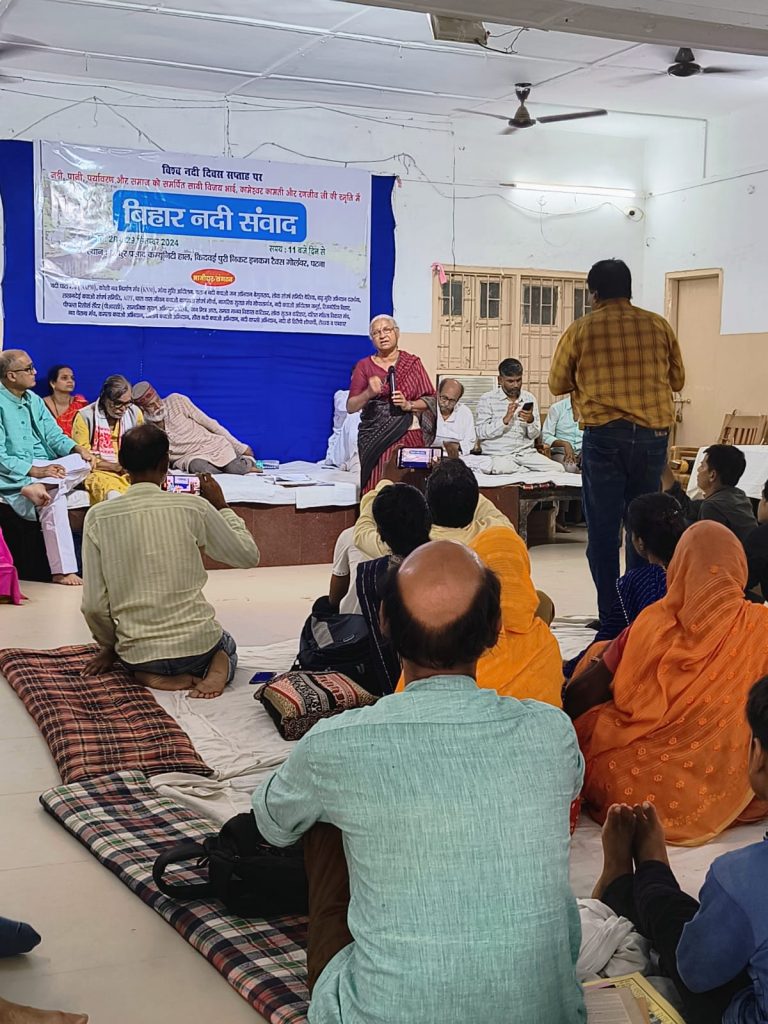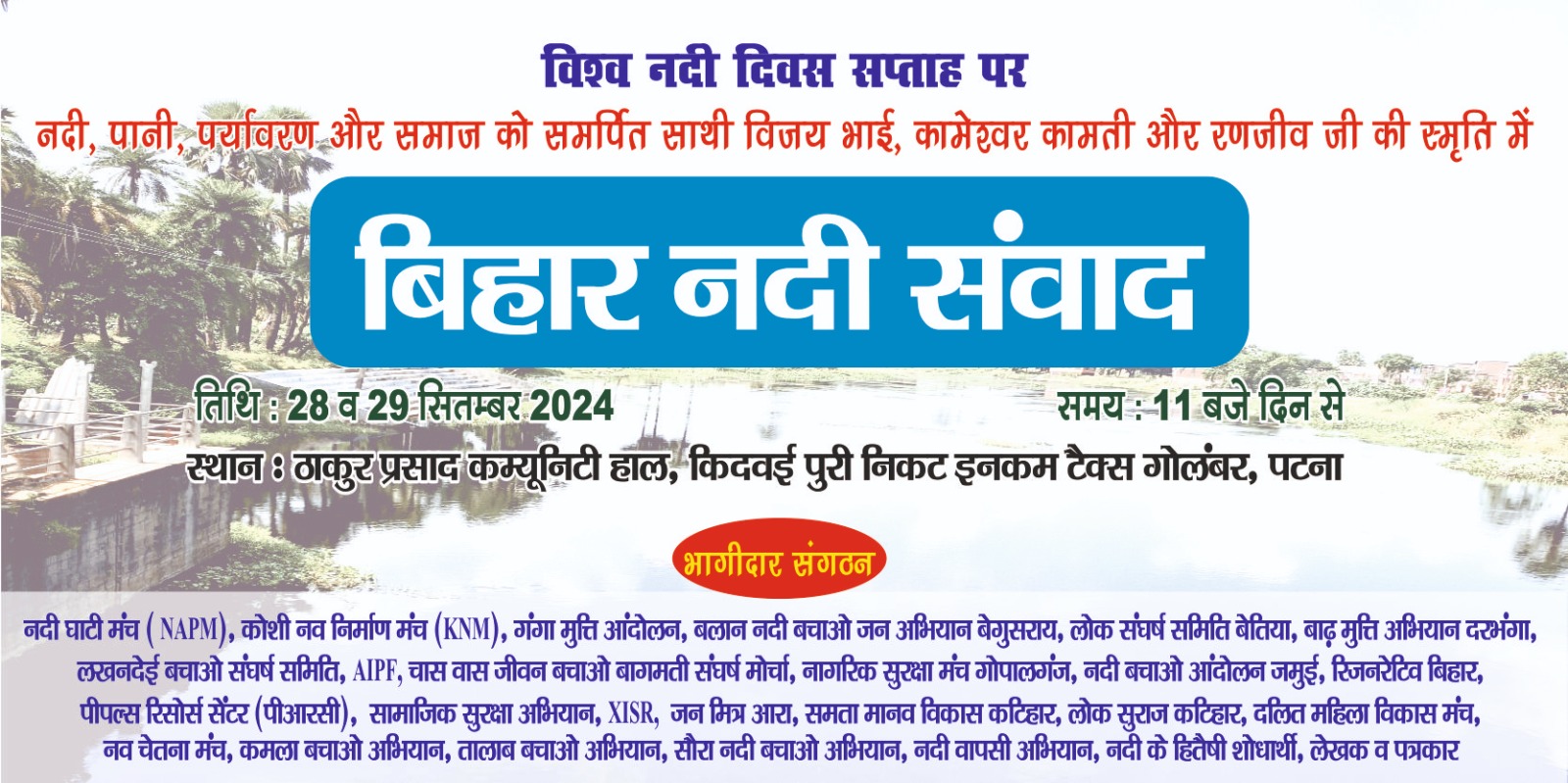With the late heavy downpour of rain, rivers in Bihar are inundating. Several areas have been affected by flood, chief among them are Kosi and Ganga. There has been flooding in the Gomati river of West Champaran too.
Furthermore, three dozen rivers have died in Bihar according to a Down to Earth report. One among them is the Falgu river, where people of Hindu persuasion perform pind daan, a post-funeral practice among Hindus.
In this backdrop, the Bihar Nadi Samvad held in Patna, called for a statewide action plan for the upkeep of endangered rivers in Bihar. Amidst the flooding situation, the discussants pondered over strategies to deal with the recurrent flood situation in Bihar.
The discussions highlighted that from the origin of rivers to their final fate in oceans, rivers have been encumbered by human activities. In the Himalyan mountains where most of Bihar rivers originate, river flow is disturbed by the construction of dams and barrages. Colloquially called Tatbandhi (barrages), it is dangerous during the earthquake because the rivers in the India-Nepal border in the Bihar region are prone to earthquakes.
A critical insight during the discussions was the protection and upkeep of small rivers of Bihar which form a . Small rivers are very important for the ecosystem of rural areas for agriculture and water recharge and are increasingly at risk of extinction. An activist involved in rejuvenating an extinct small river in Bihar highlighted that small rivers are ever more critical and face insurmountable risks due to human activities, including sand mining. The activist was a significant resource person during the Lakhandehi river rejuvenation movement in Sitamarhi, which originated in Nepal and entered Sonbarsa in India.

Narmada Bachao Andolan activist Medha Patkar emphasised that more than natural disasters, there are human-construction-led river disasters, including the Teesta River. She highlighted that new social movements have a particular role in this attack on rivers by human activities. Social movements are also essential to mobilise the voices of marginalised groups. In addition, movements have been instrumental in providing a space for claim-making, not to mention the benefits that movements like Narmada bachao andolan provided to the people with the land, rehabilitation of 50,000 displaced people, and land for houses. Furthermore, Patkar focused her discussion on climate-change protocols shaped in international forums and argued that these protocols are usually disconnected from the lived realities, for instance, the COP28 happening in the United Arab Emirates.
Another critical aspect of human activities is riverfronts, a modern phenomenon aimed towards beautifying cities and channeling rivers for the aesthetic pleasure of the middle class. Currently there are more than 107 riverfront projects in the pipeline across the country.
Some of the riverfronts that are already being constructed are, Musi River in Hyderabad, Tapi River in Surat, Ganga in Benaras, Mula Mutha in Pune and Khan Saraswati in Indore. During the discussion, it was highlighted that riverfronts are portrayed as harmful and intended for the benefit of the people. This is where the dilemma for the riverfront begins. Riverfronts are part of urbanisation, which has implications for the urban poor. They lead to widespread demolition, displacement and dumping of construction waste into rivers. Furthermore, concerns about heritage and communal tensions also arise due to construction activities as part of riverfront construction. A case in point is the 200 crore project of Kota Riverfront on the banks of Chambal river. The construction of Kota riverfronts has led to the destruction of riverine communities including fishermen, washermen and riverine communities.
Most importantly, the discussions further highlighted the mechanistic approach to reviving dry rivers such that of Falgu in Gaya. Under the Bihar Ganga Jal Apoorti Yojana, it is planned that a total of 190.9 kilometres of pipelines would be laid along main roads for the transport of Ganga water. The main pipeline will run from Hathidah, a town in Mokama block under Patna district, to Giriyak in Nalanda district via Sarmera and Barbigha. Another pipeline will connect to Rajgir while the second will go to Nawada.
The third pipeline will go to Manpur town in Gaya district via Vanganga, Tapovan, Jethian and the village of Dashrath Manjhi from Giriyak in Patna, officials said. The Ganga water will be lifted from Hathidah which will be supplied to three central Bihar towns through pipelines. Discussants highly criticised this plan and said that the water brought from Ganga has become squalid.
In the meantime, an activist highlighted that the water brought from Hathidah to the Falgu in Gaya has become squalid and a germinating ground for insects and diseases. This shows huge neglect in the way Bihar rivers are being trammelled.
Report by Sidhant Kumar.

